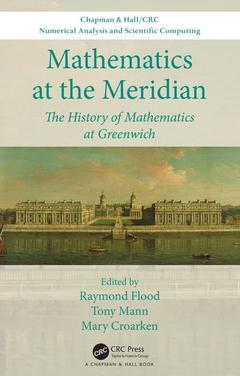Mathematics at the Meridian The History of Mathematics at Greenwich Chapman & Hall/CRC Numerical Analysis and Scientific Computing Series
Coordonnateurs : Flood Raymond, Mann Tony, Croarken Mary

Greenwich has been a centre for scientific computing since the foundation of the Royal Observatory in 1675. Early Astronomers Royal gathered astronomical data with the purpose of enabling navigators to compute their longitude at sea. Nevil Maskelyne in the 18th century organised the work of computing tables for the Nautical Almanac, anticipating later methods used in safety-critical computing systems. The 19th century saw influential critiques of Charles Babbage?s mechanical calculating engines, and in the 20th century Leslie Comrie and others pioneered the automation of computation. The arrival of the Royal Naval College in 1873 and the University of Greenwich in 1999 has brought more mathematicians and different kinds of mathematics to Greenwich. In the 21st century computational mathematics has found many new applications. This book presents an account of the mathematicians who worked at Greenwich and their achievements.
Features
- A scholarly but accessible history of mathematics at Greenwich, from the seventeenth century to the present day, with each chapter written by an expert in the field
- The book will appeal to astronomical and naval historians as well as historians of mathematics and scientific computing.
Introduction. The King’s Observatory at Greenwich and the first Astronomers Royal: Flamsteed to Bliss. Greenwich, Nevil Maskelyne and the solution to the Longitude Problem. George Biddell Airy, Greenwich and the Utility of Calculating Engines. The Mathematical Riddles of Greenwich. Thomas Archer Hirst at Greenwich, 1873 – 1883. A Professor at Greenwich: William Burnside and his contributions to mathematics. L.J. Comrie: Mechanising Mathematical Tablemaking at Greenwich. The Royal Observatory 1881 – 1998. At the foot of the hill – the Royal Naval College and after. Artful Measures: Mathematical Instruments at the National Maritime Museum. Appendix – the Mathematical Tourist at Greenwich.
Raymond Flood
Raymond Flood has spent most of his academic life promoting mathematics and computing to adult audiences, mainly through his position as University Lecturer at Oxford University, in the Continuing Education Department and at Kellogg College. In parallel he has worked extensively on the history of mathematics, producing many books and other educational material.
He is Emeritus Fellow of Kellogg College, Oxford, having been Vice-President of the College and President of the British Society for the History of Mathematics before retiring in 2010. He was Gresham College Professor of Geometry from 2012 to 2016. He is a graduate of Queen’s University, Belfast; Linacre College, Oxford; and University College, Dublin where he obtained his PhD.
Tony Mann
Tony Mann is Director of Greenwich Maths Centre at the University of Greenwich, where he has taught for many years. He is a past President of the British Society for the History of Mathematics, and has published on mathematics in Victorian Scotland and on mathematics in fiction. He is a former Visiting Professor of Computing Mathematics at Gresham College.
As a former undergraduate at Pembroke College Cambridge, with which Burnside was closely connected, Tony is pleased to have edited, with Peter M. Neumann and Julia Tompson, The Collected Papers of William Burnside (Oxford University Press, 2004).
Mary Croarken
Mary Croarken started her academic career at the University of Warwick with a degree in Computer Science and then a PhD in History of Computing. Mary has subsequently held a series of academic fellowships including the Sackler Fellowship at the Centre for Maritime Research at the National Maritime Museum (NMM) 2000 – 2002. While at NMM, she helped to organise a joint NMM and British Society for the History of Mathematics conference called Greenwich: Some Mathematical Connections which provided the inspiration for this book. Mar
Date de parution : 11-2019
15.6x23.4 cm
Date de parution : 11-2019
15.6x23.4 cm
Thèmes de Mathematics at the Meridian :
Mots-clés :
Gamma Draconis; George Biddell Airy; Plug Board; Astronomers Roya; Young Men; National Maritime Museum; HMS Challenger; Royal Naval College; Pole Star; Nevil Maskelyne; King George III; Nautical Almanac; Public Engagement; Lunar Distance Method; Royal Mathematical School; Royal Hospital School; Royal Observatory; London Mathematical Society; Trinity Laban Conservatoire; Nautical Almanac Office; Lunar Distance; Nautical Astronomy; John Flamsteed; Restricted Burnside Problem; Finite Simple Groups; British Tabulating Machine Company; Carte Du Ciel; Babbage’s Engine


